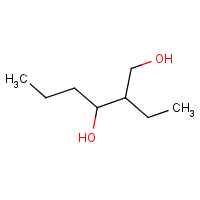Ethohexadiol
Agent Name
Ethohexadiol
Alternative Name
2-Ethyl-1,3-hexanediol
CAS Number
94-96-2
Formula
C8-H18-O2
Major Category
Other Classes

Synonyms
2-Ethyl-1,3-hexanediol; 2-Ethyl-1,3-hexylene glycol; 2-Ethyl-3-propyl-1,3-propanediol; 3-Hydroxymethyl-n-heptan-4-ol; 6-12; 6-12 insect repellent; 6-12-Insect repellent; Carbide 6-12; Compound 6-12 insect repellent; Diol-Kyowa 8; Latka 612 [Czech]; Octylene glycol; Repellent 612; Rutgers 612; [ChemIDplus]
Category
Alcohols and Polyols, Other
Description
Colorless, odorless, hygroscopic liquid; [Hawley]
Sources/Uses
Used as a solvent for resins; as a plasticizer; as a chemical intermediate in the production of polyurethane resins; as an insect repellent; in cosmetics; as a vehicle and solvent in printing inks; in medicines; as a chelating agent for boric acid; [HSDB]
Comments
A moderate eye and mucous membrane irritant; Skin absorption may cause CNS depression; [HSDB] Produces birth defects when given to rats in high doses; No data on human exposure; [REPROTOX] Effects in high-dose animal studies include ataxia, somnolence, and liver changes; [RTECS] An irritant; May cause serious injury to eyes; May be absorbed through skin; [MSDSonline]
Restricted
Except for cosmetics, voluntarily removed from US and Canadian markets in 1991 after high-dose animal experiment showed poor lung expansion in offspring; [REPROTOX]
Biomedical References
Exposure Assessment
Lethal Concentration
LC (rat) > 4,800 ppm/8h
Explanatory Notes
Flash point = 127 deg C; VP < 0.01 mm at 20 deg C; [Merck Index]
NFPA
must be preheated
Adverse Effects
Neurotoxin
Acute solvent syndrome
Hepatotoxin
Hepatoxic (a) from occupational exposure (secondary effect) or (b) in animal studies or in humans after ingestion
Reproductive Toxin
Yes
Diseases, Processes, and Activities Linked to This Agent
Diseases
Occupational diseases associated with exposure to this agent: